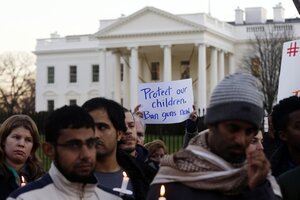A bridge for action after Sandy Hook shootings
Americans were united over the weekend on the need for solutions to mass shootings like that at Sandy Hook school in Newtown, Conn. Now they must also deal with their respective fears over the different solutions being proposed.

Supporters of gun control gathered in front of the White House Dec. 14 during a vigil for the victims of the shooting at Sandy Hook Elementary School in Newtown, Conn. They called on President Obama to push for strong gun control laws.
AP
As happened after the 9/11 attacks, Americans were united for a long moment last Friday when 20 small children and six adults were gunned down at the Sandy Hook Elementary School in Newtown, Conn. The country came together in yearning for ways to prevent yet another mass shooting, especially of children.
This moment of unity should not be forgotten as Americans now seem divided on solutions to stopping such violence. In fact, President Obama was careful in his comments following the tragedy not to lay down specific actions, only to say that “meaningful action” must be taken. He, like many others, has seen how little was done after other mass slaughters in public places.
The Sandy Hook killings had two elements similar to many previous shootings: a shooter in need of mental treatment and the use of powerful – and legal – guns.
Those who oppose more gun regulations focus on the need to deal more effectively with the mentally ill – just as they often say that it is criminals, not guns, who commit violence.
Those who favor more gun regulation say that the easier and quicker path is to tighten controls of the 300 million guns in circulation and curb access to guns by controlling unlicensed, private sellers.
This split is reflected in a Pew Research Center poll that shows 47 percent of Americans support more gun restrictions, while 46 percent favor protection of gun rights. It also showed up over the weekend in reactions by political leaders.
“The more realistic discussion is, how do we target people with mental illness who use firearms?” said Rep. Mike Rogers (R) of Michigan, a former FBI agent. Another Republican congressman, Rep. Louie Gohmert of Texas, suggested that the Sandy Hill school officials should have been armed, suggesting the killings could have been prevented that way.
The other side was just as specific. Congress must “reinstate the assault weapons ban, limit the size of clips to maybe no more than 10 bullets per clip and ... make it harder for mentally unstable people to get guns,” said Sen. Chuck Schumer (D) of New York.
Perhaps the suggestion that was closest to a middle-ground position came from Sen. Joseph Lieberman (Ind.) of Connecticut. He called for a national commission on mass violence to make sure “the heartbreak and anger we feel now is not dissipated over time or lost in legislative gridlock.”
This great divide over gun violence and gun rights does have one common denominator. Both sides have fears that drive their positions.
Those in favor of unregulated guns are afraid of losing their use of guns for sport, of losing an ability to deal with personal threats to themselves, or even of government someday acting against “the people.”
Those who seek more gun regulation are afraid that without it, guns will “get into the wrong hands” and inflict far more violence than other personal weapons like knives. They see more violence, either from legal guns used in personal, emotional arguments or the use of illegal guns in stranger-to-stranger killings.
The nation cannot move forward in ending mass shootings unless both sides acknowledge each other’s respective fears. A willingness to accept the vulnerability of the other’s fears is a way to develop a climate of trust – or empathy – that is necessary for compromise and solutions.
Trust requires that each side feel it won’t be exploited in negotiations over which solutions to focus on. It is the primary path to narrow down the expectations and emotions that surround the issue of public violence.
Many big cities, such as Boston and Philadelphia, have found ways to bring opposing sides together to deal with rampant gun violence. Those urban models of building trust among factions can serve the United States at a key moment when Americans feel some sense of group identity in solving a disturbing trend in mass shootings.

